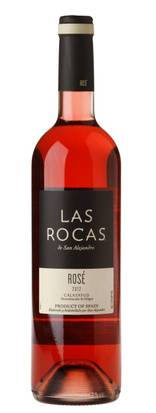Las Rocas, Calatayud (Spain) Rosé 2013 (Las Rocas USA, $14): Surprises are fun. When I settled into a blind tasting of dry rosé wines I figured that my favorite would be one of the really interesting rosés before me from Washington state, or maybe an Italian rosato. But this great-value rosé from Spain emerged as the wine of the night. Not only  that: It’s not from one of the predictable wine regions of Spain, such as Rioja or Navarra; it’s a rosado from a wine zone that I couldn’t spell correctly until this wine gave me the chance to practice.
that: It’s not from one of the predictable wine regions of Spain, such as Rioja or Navarra; it’s a rosado from a wine zone that I couldn’t spell correctly until this wine gave me the chance to practice.
This wine hails from the DO region of Calatayud, in northeastern Spain. Calatayud borders on the slightly better-known wine zone of Cariñena to its east and, like that zone and the somewhat recognizable DO of Somontano, it is in the province of Aragon. To its north a bit in the same province is the Campo de Borja DO zone, which brings you close to the famous wine regions of Navarra and Rioja. But essentially, Calatayud is in the middle of nowhere, in a section of Spanish wine country that has failed to earn an entry in the World Atlas of Wine.
Calatayud is an arid wine region with high altitude vineyards, rocky soil, and sparse crop levels. Garnacha — Grenache — is the dominant grape variety, and this Las Rocas Rosé is in fact entirely Garnacha. Although Grenache is the source of many insipid rosé and red wines, when the vines are old and/or the yields are low this variety can make exciting wines; this particular rosé of Garnacha comes from fifty- to eighty-year-old vines.
The first thing I noticed about this wine, apart from its lovely aroma of red berries, was how dry it is. True, every wine in my tasting was a dry rosé, but dryness is often a relative term; several of the wines were merely dryish, and some of the wines were soft and generous, in a style that might not appeal to purists. The Las Rocas Rosé is dry and it is also crisp, with a steely demeanor that excites rather than soothes.
This wine is fairly full-bodied for a rosé. Its flavors of raspberry, cranberry, and stony minerality are pronounced and show surprisingly good concentration. I say “surprisingly” for two reasons: no other rosé in my tasting evoked any concept of concentration; and, after all, this is an inexpensive wine. In fact, this wine hits all the quality markers that you would demand of a good red or white wine but might forgive a rosé for lacking, such as depth, length, concentration, and distinctiveness of expression. It is well made and expressive, and it has character.
Another element of surprise is that this wine is produced by Bodegas San Alejandro, which is a grape growers’ cooperative. Most Calatayud wines are produced by cooperatives, and although many cooperatives across Europe issue large volumes of very ordinary wine, that is clearly not the case here. The wine is also marketed in the U.S. by a giant, the import division of Gallo, and should be widely available across the U.S.
90 Points
